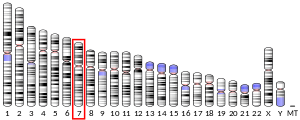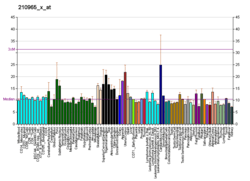CDK13
Cyclin dependent kinase 13 is an enzyme that in humans is encoded by the CDK13 gene.[5][6]
The protein encoded by this gene is a member of the cyclin-dependent serine/threonine protein kinase family. Members of this family are well known for their essential roles as master switches in cell cycle control. Some of the cell cycle control kinases are able to phosphorylate proteins that are important for cell differentiation and apoptosis, thus provide connections between cell proliferation, differentiation, and apoptosis. Proteins of this family may also be involved in non-cell cycle-related functions, such as neurocytoskeleton dynamics. The exact function of this protein has not yet been determined. It has unusually large N- and C-termini and is ubiquitously expressed in many tissues. Two alternatively spliced variants are described.[6]
Clinical significance
Mutations in CDK13 cause CDK13-related disorder. A 2017 study of children with rare developmental disorders found 11 children in the United Kingdom who had a fault in their CDK13 gene.[7] This fault affected the children's communication and language skills as well as causing learning difficulties.[8]
References
- GRCh38: Ensembl release 89: ENSG00000065883 - Ensembl, May 2017
- GRCm38: Ensembl release 89: ENSMUSG00000041297 - Ensembl, May 2017
- "Human PubMed Reference:". National Center for Biotechnology Information, U.S. National Library of Medicine.
- "Mouse PubMed Reference:". National Center for Biotechnology Information, U.S. National Library of Medicine.
- Lapidot-Lifson Y, Patinkin D, Prody CA, Ehrlich G, Seidman S, Ben-Aziz R, Benseler F, Eckstein F, Zakut H, Soreq H (Feb 1992). "Cloning and antisense oligodeoxynucleotide inhibition of a human homolog of cdc2 required in hematopoiesis". Proc Natl Acad Sci U S A. 89 (2): 579–83. doi:10.1073/pnas.89.2.579. PMC 48282. PMID 1731328.
- "Entrez Gene: CDC2L5 cell division cycle 2-like 5 (cholinesterase-related cell division controller)".
- McRae, Jeremy F.; Clayton, Stephen; Fitzgerald, Tomas W.; Kaplanis, Joanna; Prigmore, Elena; Rajan, Diana; Sifrim, Alejandro; Aitken, Stuart; Akawi, Nadia (2017). "Prevalence and architecture of de novo mutations in developmental disorders" (PDF). Nature. 542 (7642): 433–438. doi:10.1038/nature21062. hdl:20.500.11820/a89badba-7288-4be1-b3c5-a9b9e61d920d. PMC 6016744. PMID 28135719.
- Walsh, Fergus (2017-01-25). "Child gene study identifies new developmental disorders". BBC News. Retrieved 2017-01-27.
External links
Further reading
- Maruyama K, Sugano S (1994). "Oligo-capping: a simple method to replace the cap structure of eukaryotic mRNAs with oligoribonucleotides". Gene. 138 (1–2): 171–4. doi:10.1016/0378-1119(94)90802-8. PMID 8125298.
- Mackenzie LF, Brooke GS, Cutfield JF, et al. (1997). "Identification of Glu-330 as the catalytic nucleophile of Candida albicans exo-beta-(1,3)-glucanase". J. Biol. Chem. 272 (6): 3161–7. doi:10.1074/jbc.272.6.3161. PMID 9013549.
- Suzuki Y, Yoshitomo-Nakagawa K, Maruyama K, et al. (1997). "Construction and characterization of a full length-enriched and a 5'-end-enriched cDNA library". Gene. 200 (1–2): 149–56. doi:10.1016/S0378-1119(97)00411-3. PMID 9373149.
- <Please add first missing authors to populate metadata.> (1999). "Toward a complete human genome sequence". Genome Res. 8 (11): 1097–108. doi:10.1101/gr.8.11.1097. PMID 9847074.
- Marqués F, Moreau JL, Peaucellier G, et al. (2001). "A new subfamily of high molecular mass CDC2-related kinases with PITAI/VRE motifs". Biochem. Biophys. Res. Commun. 279 (3): 832–7. doi:10.1006/bbrc.2000.4042. PMID 11162436.
- Nagase T, Nakayama M, Nakajima D, et al. (2001). "Prediction of the coding sequences of unidentified human genes. XX. The complete sequences of 100 new cDNA clones from brain which code for large proteins in vitro". DNA Res. 8 (2): 85–95. doi:10.1093/dnares/8.2.85. PMID 11347906.
- Strausberg RL, Feingold EA, Grouse LH, et al. (2003). "Generation and initial analysis of more than 15,000 full-length human and mouse cDNA sequences". Proc. Natl. Acad. Sci. U.S.A. 99 (26): 16899–903. doi:10.1073/pnas.242603899. PMC 139241. PMID 12477932.
- Hillier LW, Fulton RS, Fulton LA, et al. (2003). "The DNA sequence of human chromosome 7". Nature. 424 (6945): 157–64. doi:10.1038/nature01782. PMID 12853948.
- Ota T, Suzuki Y, Nishikawa T, et al. (2004). "Complete sequencing and characterization of 21,243 full-length human cDNAs". Nat. Genet. 36 (1): 40–5. doi:10.1038/ng1285. PMID 14702039.
- Brill LM, Salomon AR, Ficarro SB, et al. (2004). "Robust phosphoproteomic profiling of tyrosine phosphorylation sites from human T cells using immobilized metal affinity chromatography and tandem mass spectrometry". Anal. Chem. 76 (10): 2763–72. doi:10.1021/ac035352d. PMID 15144186.
- Colland F, Jacq X, Trouplin V, et al. (2004). "Functional proteomics mapping of a human signaling pathway". Genome Res. 14 (7): 1324–32. doi:10.1101/gr.2334104. PMC 442148. PMID 15231748.
- Beausoleil SA, Jedrychowski M, Schwartz D, et al. (2004). "Large-scale characterization of HeLa cell nuclear phosphoproteins". Proc. Natl. Acad. Sci. U.S.A. 101 (33): 12130–5. doi:10.1073/pnas.0404720101. PMC 514446. PMID 15302935.
- Andersen JS, Lam YW, Leung AK, et al. (2005). "Nucleolar proteome dynamics". Nature. 433 (7021): 77–83. doi:10.1038/nature03207. PMID 15635413.
- Rual JF, Venkatesan K, Hao T, et al. (2005). "Towards a proteome-scale map of the human protein-protein interaction network". Nature. 437 (7062): 1173–8. doi:10.1038/nature04209. PMID 16189514.
- Even Y, Durieux S, Escande ML, et al. (2007). "CDC2L5, a Cdk-like kinase with RS domain, interacts with the ASF/SF2-associated protein p32 and affects splicing in vivo". J. Cell. Biochem. 99 (3): 890–904. doi:10.1002/jcb.20986. PMID 16721827.
- Tsang HT, Connell JW, Brown SE, et al. (2006). "A systematic analysis of human CHMP protein interactions: additional MIT domain-containing proteins bind to multiple components of the human ESCRT III complex". Genomics. 88 (3): 333–46. doi:10.1016/j.ygeno.2006.04.003. PMID 16730941.
- Beausoleil SA, Villén J, Gerber SA, et al. (2006). "A probability-based approach for high-throughput protein phosphorylation analysis and site localization". Nat. Biotechnol. 24 (10): 1285–92. doi:10.1038/nbt1240. PMID 16964243.
- Olsen JV, Blagoev B, Gnad F, et al. (2006). "Global, in vivo, and site-specific phosphorylation dynamics in signaling networks". Cell. 127 (3): 635–48. doi:10.1016/j.cell.2006.09.026. PMID 17081983.




